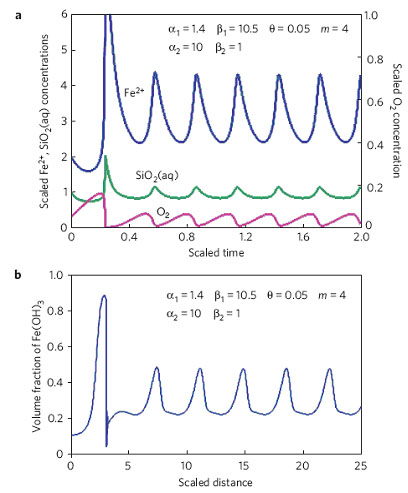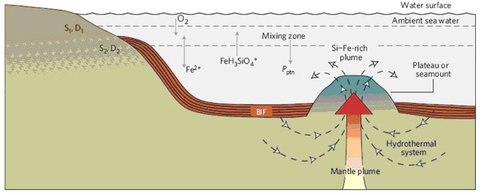2009 Annual Science Report
 University of Wisconsin
Reporting | JUL 2008 – AUG 2009
University of Wisconsin
Reporting | JUL 2008 – AUG 2009
Alternative Formation Mechanisms for Banded Iron Formations
Project Summary
Based on field observations during the 2008 BIF filed trip and laboratory investigation, we have proposed a new generation mechanism for the banded iron formations, very important rocks that recorded early earth conditions and environment. Our new model shows how BIFs could have formed when hydrothermal fluids from the interaction between seawater and komatiite (Al-depleted rock) that comes from hot and deep Earth’s mantle, mixed with surface seawater. This mixing triggered the dynamics of oscillation between iron- and silica-rich minerals, which were deposited in layers on the seafloor.
Project Progress
The chemical signatures and mineralogy of banded iron formations have the potential to provide information about the ocean environment on early Earth. Their formation requires iron- and silicon-rich fluids, but the mechanisms by which the alternating layers of Si- and Fe-rich rock formed remain controversial. We use thermodynamic calculations to show that Fe- and Si-rich fluids can be generated by hydrothermal leaching of low-Al oceanic crustal rocks such as komatiites. We find that positive feedbacks occur among the chemical reactions when hydrothermal fluids mix with ambient sea water. These feedbacks lead to alternating precipitation of Fe and Si minerals, owing to the formation of complexes between Fe(II) and silicic acid (Fig. 1). We suggest that the small-scale (<1 cm) banding was produced by internal dynamics of the geochemical system, rather than any external forcing (Fig. 2). As the Archaean eon progressed, the oceanic crust produced was rich in Al. When Al-rich crust undergoes hydrothermal alteration, Fe is locked in Al–Fe silicate minerals. This results in iron depleted hydrothermal fluids, and thus prevents the deposition of Fe-rich minerals. We therefore conclude that the widespread cessation of banded iron formation deposition ~1.7 billion years ago reflects the changing composition of the oceanic crust (Wang et al., 2009).
Fig. 1: The ambient seawater could be either oxic or anoxic (only the former is shown here). Komatiitic rocks formed as a part of plateaus or seamounts above a deep mantle plume. Periodic precipitation of iron oxide and silica was induced through a self-organization mechanism. Pptn – mineral precipitation; S1, D1 – the area of the upper surface of the mixing zone and the corresponding mass exchange coefficient for mixing, respectively; S2, D2 – the area of the lower surface of the mixing zone and the corresponding mass exchange coefficient for mixing, respectively.

Fig. 2: Self-organized oscillatory precipitation of banded iron formation (BIF) in a mixing zone of a Si-Fe-rich hydrothermal fluid with the ambient seawater. The dissolved concentrations are scaled to their boundary values.
Publications
-
Wang, Y., Xu, H., Merino, E., & Konishi, H. (2009). Generation of banded iron formations by internal dynamics and leaching of oceanic crust. Nature Geosci, 2(11), 781–784. doi:10.1038/ngeo652
-
PROJECT INVESTIGATORS:
-
RELATED OBJECTIVES:
Objective 4.1
Earth's early biosphere.

